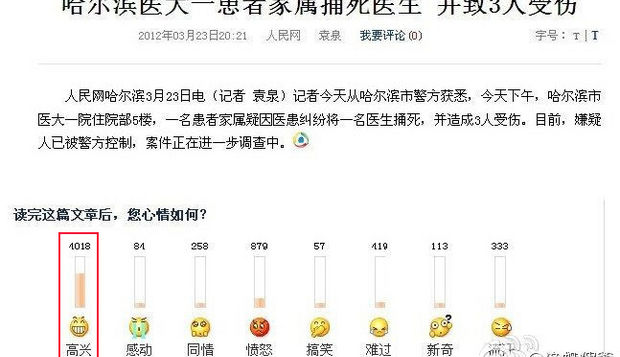The medical community in China’s Heilongjiang province paused earlier this week to mourn the death of an intern, Wang Hao, who was killed by a 17-year hospital patient. From Xinhua News:
Health Minister Chen Zhu issued a statement Tuesday, mourning the loss and calling for the murderer to be severely punished.
The incident occurred at 4:30 p.m. Friday when a patient allegedly attacked Wang and three other medical workers at the hospital with a knife.
The injuries of the other three were serious but not life threatening, according to local police.
Police captured the alleged attacker, a 17-year-old man named Li Mengnan, when he was receiving emergency treatment as he tried to kill himself following the attack.
Li was suffering from ankylosing spondylitis, a long-term disease that causes inflammation around the spinal vertebrae. He told the police that doctors at the hospital had a terrible attitude and “deliberately rejected” treating him. He said this was the motivation for his attack.
Bloomberg’s Adam Minter reported today that violence against doctors, including murder, has reportedly increased over the past few years and affected roughly 70 percent of all public hospitals in China in 2010:
Why so much violence against one of the caring professions? Chinese media, and microblogs, are filled with theories.
In 2007, Xinhua, the state-owned news agency, explained it as a function of “patients’ families and friends [becoming] more likely to use violence to vent their rage over hospital errors.” There’s some truth to that. China lacks a credible and independent medical malpractice system to determine compensation for medical errors. But that’s just the beginning. The more critical issue relates to the comically low compensation medical professionals receive (the starting salary for a doctor is around $500 per month). To supplement their income, they legally receive commissions on prescriptions and medical services. On Thursday, Shanghai media reported that the city’s doctors also commonly notify funeral homes of impending patient deaths inexchange for kickbacks.
Chinese patients often enter a hospital prepared to pay bribes for the care that they need. I’ve personally witnessed a “tip” handed to a doctor in advance of a surgical procedure at a top Shanghai hospital. They can also be tricked into undergoing unnecessary but revenue-generating procedures. Three years ago, for instance, at another Shanghai hospital, I was told I should get a CT scan so as to better understand the causes of a sinus infection, and then asked to purchase a Percocet prescription to manage my pain. I didn’t need either. Combine this norm, however, with crowded waiting rooms, high and expensive hurdles to see specialists, and a pointed lack of means to civilly contest malpractice and one can see why resentment against the Chinese medical profession has boiled for decades.
Minter also calls attention to a now-deleted survey posted by The People’s Daily, in which an overwhelming 65% of the more than 6,000 respondents indicated a happy reaction to Wang Hao’s murder (screen shot below, via Bloomberg). Another survey, taken after Wang Hao’s murder and published by The Global Times on Wednesday, showed that nearly 63% of respondents have a negative impression of Chinese medical staff.
A China Daily piece published Thursday bemoaned the “institutional factors that lead to an erosion of trust in doctors,” and called for better protocol to resolve hospital disputes:
In public reports on cases involving violence in Chinese hospitals, almost every incident has been associated with medical malpractice disputes. In other words, patients resort to violence when they feel there is no proper mechanism to resolve malpractice disputes.
In many other countries, tort law, arbitration and mediation are the most common mechanisms to resolve medical malpractice disputes and determine the liability of the hospital, physicians and patients. In China, these mechanisms are not very effective due to poor institutional design.
This is because in China these mechanisms depend on authentication committees, which decide whether there has been a medical mistake or negligence. However, in many cases, the members of an authentication committee are selected from local doctors and remain anonymous to patients. At the same time, most Chinese hospitals are public hospitals managed by the local health bureau; as a result, the decision-making process is not perceived to be independent and credible.
Further, without a creditable malpractice system, hospitals have no incentive to buy malpractice insurance, which is widely used in the United States as an important mechanism to compensate patients.
…
In times of sickness and emotional instability, perceptions are a critical determinant of behavior, and patients’ perceptions that they are not being cared for properly can result in violence. It is important, therefore, that rational institutional design plays a part in providing incentives for cool-headed, peaceful resolutions to disputes.







